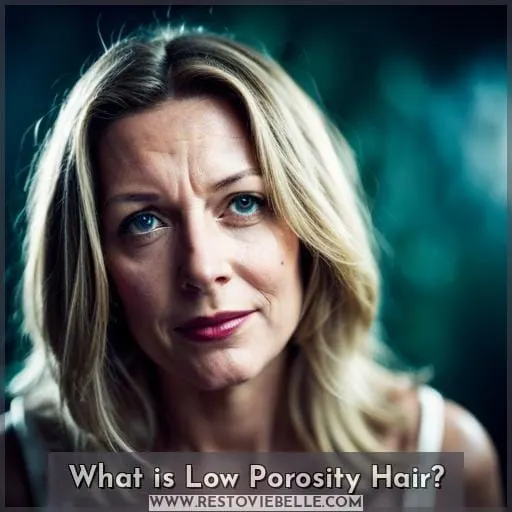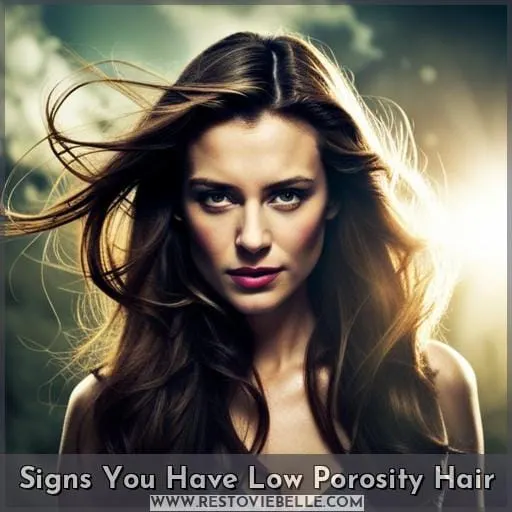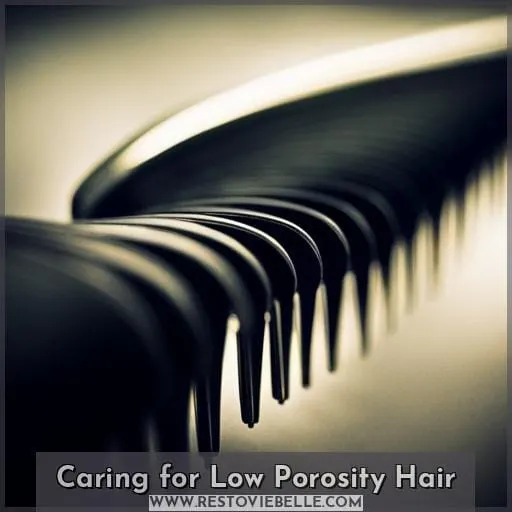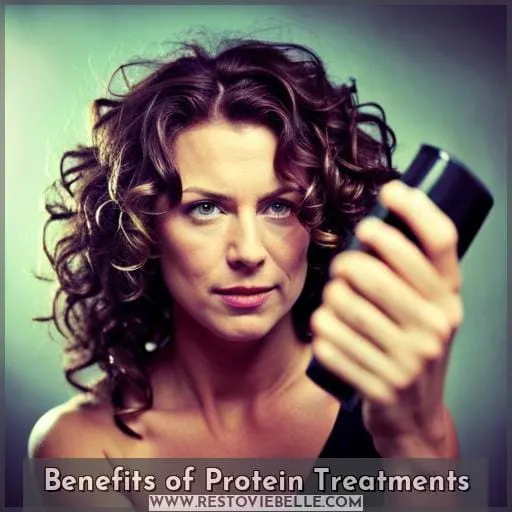This site is supported by our readers. We may earn a commission, at no cost to you, if you purchase through links.
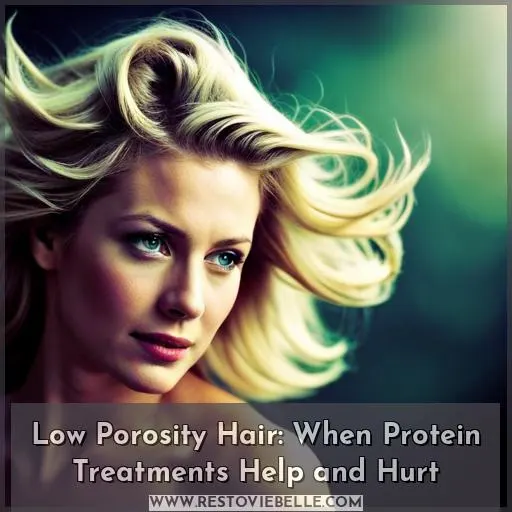 Wonderin’ if proteins can help your low porosity locks? Your hair’s like a sponge that can’t absorb moisture.
Wonderin’ if proteins can help your low porosity locks? Your hair’s like a sponge that can’t absorb moisture.
We’ll explore what porosity means, how to care for your mane, when proteins help make hair stronger, and risks of overdoin’ it.
Table Of Contents
- Key Takeaways
- What is Low Porosity Hair?
- Signs You Have Low Porosity Hair
- Caring for Low Porosity Hair
- Are Protein Treatments Bad?
- Benefits of Protein Treatments
- Risks of Too Much Protein
- Frequently Asked Questions (FAQs)
- Should I do a porosity test before using protein treatments?
- How often can I use a protein treatment on my low porosity hair?
- What ingredients should I look for in a protein treatment made for low porosity hair?
- Can I use a protein treatment right after coloring my low porosity hair?
- Will a protein treatment help low porosity hair that has heat damage?
- Conclusion
Key Takeaways
- Protein treatments can strengthen hair, prevent breakage, and repair damage in low porosity hair when used properly
- Overdoing protein treatments on low porosity hair can lead to product buildup or cause hair to become stiff/brittle
- It’s important to do a porosity test before using protein treatments on low porosity hair to assess hair’s current protein/moisture balance
- The frequency of protein treatments for low porosity hair depends on hair’s needs – avoiding over-use that could cause protein overload
What is Low Porosity Hair?
You’ve got low porosity hair if your strands don’t easily absorb moisture or hair products. This is because the cuticle layer lies flat, blocking moisture from penetrating the hair shaft.
To test porosity, do the float test – place a clean strand in room temperature water. If it floats right away instead of sinking, that signals low porosity. You can also spray water on your hair to test absorption.
In contrast, high porosity hair has a raised cuticle that lets in moisture very quickly.
To care for low porosity hair, focus on opening up the cuticle before washing and conditioning to allow thorough cleansing and moisture penetration.
Signs You Have Low Porosity Hair
You know your hair has low porosity if it has difficulty absorbing moisture and products.
It may be hard to get your hair wet or have it respond well to protein treatments.
Signs include lack of elasticity, frizziness, inability to retain moisture, and resistance to penetration by oils or conditioners.
Doesn’t Absorb Products Well
Because of its tightly closed cuticle, with low porosity hair you’ll notice products sitting on top instead of soaking in.
Shampoos, conditioners, leave-ins and stylers will bead up and slide right off rather than penetrating strands.
This causes issues like product build-up and dry, brittle hair over time if not properly managed.
Using lighter products, applying in sections and incorporating steam can help products better absorb.
Hard to Get Wet
When Protein Treatments Help and Hurt:
Another sign you have low porosity hair is it’s difficult to get wet when washing or wetting your hair.
- Strands float rather than sink when doing a hair porosity test
- Hair takes longer to get soaked, with water beading up on strands
- Using conditioners or treatments is less effective since products sit on top
Doesn’t Respond to Protein
You don’t see much improvement after using protein treatments on your hair. This could be another sign you have low porosity hair that resists absorbing external proteins.
Protein treatments may just sit on top of the cuticle instead of penetrating the hair shaft.
Try using a clarifying shampoo beforehand to open cuticles.
Alternatively, apply heat or steam to help the treatment absorb better.
Monitor your hair’s response. If it still seems stiff or straw-like, protein may not be ideal for your strands. Consider lighter protein alternatives like rice water or hydrating masks using humectants like honey or glycerin.
Caring for Low Porosity Hair
When caring for low porosity hair, it’s important to pay attention to the cleansing and moisturizing process.
- Use a clarifying shampoo to remove buildup.
- Follow up with a lightweight, moisturizing conditioner.
To ensure even distribution of products, apply them in sections rather than all at once.
Additionally, incorporating steam treatments or using humectants can help open up the cuticle layer and attract moisture into the hair shaft for better absorption.
Cleansing
To properly cleanse low porosity hair, start by using a gentle clarifying shampoo to remove buildup without stripping oils.
Alternatively, try co-washing more frequently to cleanse hair while retaining moisture. Use cool water and focus on stimulating the scalp to remove residue. Be patient and gentle when rinsing.
Moisturizing
To effectively care for low porosity hair, moisturization is key. Low porosity hair has difficulty absorbing water and products due to the tightly closed cuticle scales. To maintain proper hydration balance, it’s important to use humectants that attract moisture and sealants that lock in hydration.
Look for lightweight oils like argan or jojoba oil as sealant options. Avoid heavy butters or silicones that can weigh down the hair and prevent absorption.
Moisturizing Tips:
- Use humectants to attract moisture
- Apply lightweight oils as sealants
- Avoid heavy butters and silicones
Applying Products in Sections
By applying products in sections, you’re better able to ensure even coverage.
- For thin hair, use wider sections.
- For thick hair, use smaller sections.
- On wet hair, use more product.
- On dry hair, use less product to avoid buildup.
- Clarify with a shampoo if you notice residue.
- Make sections clean and neat for precision.
- Tailor section size and product amount to hair thickness and moisture level.
Using Steam
After applying products in sections, you’re able to open the cuticle and improve absorbency by using steam on low porosity hair.
Directing steam onto strands enables moisture to penetrate more effectively since heat opens the tight cuticles, allowing conditioners and treatments to be better absorbed.
This steam treatment also aids detangling and makes hair more pliable for styling.
With cuticles relaxed, humectants then attract and seal in moisture.
Humectants
You can attract and seal in moisture by using humectants on your low porosity hair.
- Glycerin – Draws moisture from the air into your hair
- Honey – Natural humectant that seals in moisture
- Aloe vera – Prevents frizz and adds shine
- Agave nectar – Improves elasticity by trapping moisture
Humectants are critical for low porosity hair to keep it hydrated and prevent breakage.
Are Protein Treatments Bad?
One claim you may hear is that protein treatments are bad for low porosity hair.
However, used properly, targeted protein treatments offer multiple benefits for struggling strands.
Introducing proteins can strengthen weak areas and increase elasticity. This reduces breakage.
Occasional treatments also help moisture penetrate the cuticle layer more easily over time.
Still, improper use carries risks. Excess protein leads to brittleness or stiffness.
But with the right product, technique and timing, proteins reinforce low porosity hair beautifully.
Seek balance. Discover what your hair craves, when it needs a protein boost and how much it can handle.
Then give it the care it deserves.
Benefits of Protein Treatments
Protein treatments can be incredibly beneficial for low porosity hair.
They help to strengthen the hair, prevent breakage, and improve manageability.
By incorporating protein treatments into your hair care routine, you can enjoy stronger, healthier-looking hair that’s more resistant to damage.
Protein for low porosity?
When it comes to low porosity hair, protein treatments can be incredibly beneficial for improving its overall health and appearance.
- Strengthens hair and prevents breakage
- Repairs damage to the hair shaft
- Makes hair more manageable and easier to style
Protein fills in gaps in the hair cuticle, making strands less prone to breakage. It also helps repair split ends and other damage. Additionally, protein makes curls springier, more defined, and easier to detangle.
However, too much protein can cause brittleness. To avoid this, use a protein treatment once every 4-6 weeks based on your hair’s needs.
Benefits of protein?
Two key benefits you’re getting from protein treatments are:
- Strengthening hair to prevent breakage
- Helping repair damage to the hair shaft
Protein improves elasticity so hair resists damage.
It reduces frizz by fortifying and smoothing the cuticle.
Protein helps hair better absorb and retain moisture.
It prevents buildup so nutrients can penetrate.
Ultimately, protein promotes growth of healthy, strong strands.
Risks of protein?
You should know that overdoing protein treatments carries risks like:
- Making your hair stiff
- Brittle
- Difficult to style
- Even causing breakage.
Too much protein can overload your strands, leading to a protein buildup that makes hair unmanageable.
Seeking balance is key – be attentive to signs of protein sensitivity or deficiency in your strands.
- Dryness
- Brittleness
- Breakage
- Or limp strands needing a boost.
As your trusted stylist, I’ll help assess your protein needs for hair that’s touchably soft yet strong.
Risks of Too Much Protein
One risk of overusing protein treatments is they can make low porosity hair stiff and brittle over time.
While protein treatments are beneficial for strengthening the hair, using them too frequently or in excess can lead to problems.
Protein buildup occurs when there’s an excessive amount of protein on the hair shaft, causing it to become dry and brittle.
This can result in increased breakage and even hair loss if not addressed properly.
It’s important to find a balance with protein treatments by following recommended usage guidelines and incorporating other moisturizing products into your routine as well.
Regular deep conditioning sessions can help counteract any potential damage caused by excessive proteins, ensuring that your low porosity hair remains healthy and resilient without sacrificing its moisture balance.
Frequently Asked Questions (FAQs)
Should I do a porosity test before using protein treatments?
Yes, test first.
Knowing your hair’s porosity guides product choices, preventing damage.
Without this knowledge, misusing treatments risks breakage, frizz and failed styling.
Assess porosity before proceeding, then select ingredients wisely.
This simple step empowers healthy, manageable hair.
How often can I use a protein treatment on my low porosity hair?
You can use a protein treatment on low porosity hair every 4-6 weeks.
While protein is beneficial, overdoing treatments may cause buildup or make hair stiff.
Monitor hair health and adjust frequency as needed.
What ingredients should I look for in a protein treatment made for low porosity hair?
Look for:
- Keratin
- Collagen
- Amino acids
- Silk protein
- Wheat protein
- Soy protein
in a treatment made for low porosity hair.
Avoid harsh alcohols and stay away from treatments with too much protein, as this could make your hair brittle.
Can I use a protein treatment right after coloring my low porosity hair?
Using a protein treatment right after coloring low porosity hair can be beneficial.
It helps strengthen the hair and prevent breakage, improving its overall appearance.
Just make sure to choose a product specifically formulated for low porosity hair.
Will a protein treatment help low porosity hair that has heat damage?
A protein treatment can help low porosity hair that has heat damage by:
- Strengthening the strands
- Reducing breakage
It’s important to choose a protein treatment specifically formulated for low porosity hair for best results.
Conclusion
Like a wilted flower needing water, low porosity hair longs for moisture. Yet proteins can strengthen strands just as fertilizer nourishes plants.
Apply conditioning treatments as you’d water to a garden. Then periodically incorporate protein to patch holes—but don’t overdo it.
With balance, your locks will bloom just as vibrant blossoms in spring. Care for your mane as you’d a beloved plant, and it will thrive for years to come.

